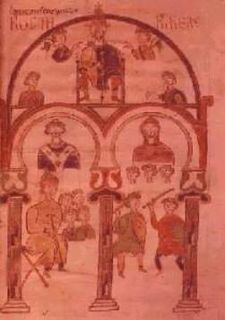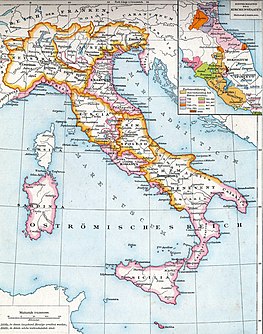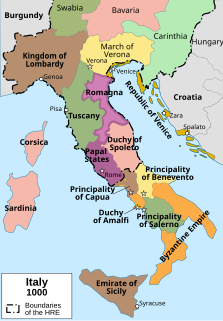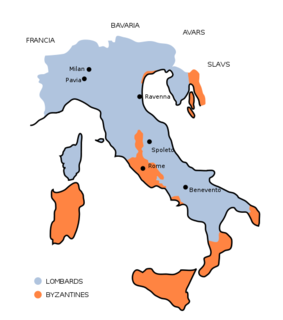The Notitia de actoribus regis ("Notice concerning royal administrators") is a series of six decrees (praecepta) promulgated by the Lombard king of Italy, Liutprand, around 733. Collectively they "detailed the duties and responsibilities of the men selected to administer royal curtes," the men referenced as actores in the title. [1] Liutprand was a prolific legislator. Besides the Notitia, he added 152 titles to the Edictum Rothari of his predecessor. [2] The Notitia is "essentially a forerunner of the Carolingian capitulary". [1] [2]

Liutprand was the King of the Lombards from 712 to 744 and is chiefly remembered for his Donation of Sutri, in 728, and his long reign, which brought him into a series of conflicts, mostly successful, with most of Italy. He is often regarded as the most successful Lombard monarch, notable for the Donation of Sutri, which was the first accolade of sovereign territory to the Papacy.

The Edictum Rothari was the first written compilation of Lombard law, codified and promulgated on 22 November 643 by King Rothari. According to Paul the Deacon, the 8th century Lombard historian, the custom law of the Lombards had been held in memory before this. The Edict, recorded in Vulgar Latin, comprised primarily the Germanic custom law of the Lombards, with some modifications to limit the power of feudal rulers and strengthen the authority of the king. Although the edict has been drafted in latin, few lombard words were untranslatable, as "grabworfin, arga, sculdhais, morgingab, metfio, federfio, mahrworfin, launegild, thinx, waregang, gastald, mundius, angargathung, fara, walupaus, gairethinx, aldius, actugild or, wegworin".
A capitulary was a series of legislative or administrative acts emanating from the Frankish court of the Merovingian and Carolingian dynasties, especially that of Charlemagne; the first emperor of the Romans in the west since the collapse of the Western Roman Empire in the late 5th century. They were so called because they were formally divided into sections called capitula.
The Latin term curtis (plural curtes) originally denoted "a complex of landed property" and came during the Lombard period to refer to the house of a free man (liber homo) with its surrounding buildings and orchards before settling to mean the administrative centre of a lord's estates. Agricultural matters were overseen by a villicus and domestic ones by a ministerialis and both were usually of the servile class, aldii . A lord, such as the king, had many curtes, each with its dominicum (the demesne), the original estate directly administered by the lord's servants, and its massaricium, the manors (mansi) owned by the lord but farmed by free or servile peasants. A curtis could be contiguous but was more often a scattering of domains in several proximal villages; it was thus an administrative, not a geographical, unit. [3]
Aldii were semifree in Germanic law. Employees of a patron, they had a position intermediate between freedom and slavery but ended up sometimes being confused with the serfs. Deprived of political and military rights and related to the land that they cultivated, they could, however, marry and be defended in court, and they were entitled to wergild and, within limits, to their property.

In the feudal system, the demesne was all the land which was retained by a lord of the manor for his own use and occupation or support, under his own management, as distinguished from land sub-enfeoffed by him to others as sub-tenants. In England, royal demesne is the land held by the Crown, and ancient demesne is the legal term for the land held by the king at the time of the Domesday Book.
The main purpose of the Notitia was to prevent the usurpation of public land by local officials. The first requirement of a potential actor was to swear on the Gospels that "if I should learn of anything that is against the regulations, I will make this known [facio notitiam] to the king, so that the matter will be resolved." [1] The term notitia may indicate a written notice or report, since the written law is itself referred to as part of a notitia. The law further declares that the government was in possession of a "list of all the territories that pertained to those estates". [4] Any purchase of royal property by one of the king's servants was to be confirmed by a royal charter and the prices were stipulated "in the edict".

The Lombards or Longobards were a Germanic people who ruled most of the Italian Peninsula from 568 to 774.

Pavia is a town and comune of south-western Lombardy in northern Italy, 35 kilometres south of Milan on the lower Ticino river near its confluence with the Po. It has a population of c. 73,000. The city was the capital of the Kingdom of the Lombards from 572 to 774.

Desiderius was a king of the Lombard Kingdom of northern Italy, ruling from 756 to 774. He is chiefly known for his connection to Charlemagne, who married his daughter and conquered his realm.

The Kingdom of France in the Middle Ages was marked by the fragmentation of the Carolingian Empire and West Francia (843–987); the expansion of royal control by the House of Capet (987–1328), including their struggles with the virtually independent principalities that had developed following the Viking invasions and through the piecemeal dismantling of the Carolingian Empire and the creation and extension of administrative/state control in the 13th century; and the rise of the House of Valois (1328–1589), including the protracted dynastic crisis of the Hundred Years' War with the Kingdom of England (1337–1453) compounded by the catastrophic Black Death epidemic (1348), which laid the seeds for a more centralized and expanded state in the early modern period and the creation of a sense of French identity.

The Duchy of Spoleto was a Lombard territory founded about 570 in central Italy by the Lombard dux Faroald. Its capital was the city of Spoleto.

The Duchy of Benevento was the southernmost Lombard duchy in the Italian peninsula, centered on Benevento, a city in Southern Italy. Being cut off from the rest of the Lombard possessions by the papal Duchy of Rome, Benevento was practically independent from the start. Only during the reigns of Grimoald, King of the Lombards and the kings from Liutprand on was the duchy closely tied to the kingdom. After the fall of the kingdom, however, alone of Lombard territories it remained as a rump state, and maintained its de facto independence for nearly three hundred years, though it was divided after 849.

Rudolph II, a member of the Elder House of Welf, was King of Burgundy from 912 until his death. He initially succeeded in Upper Burgundy and also ruled as King of Italy from 922 to 926. In 933 Rudolph acquired the Kingdom of Lower Burgundy (Provence) from King Hugh of Italy in exchange for the waiver of his claims to the Italian crown, thereby establishing the united Burgundian Kingdom of Arles.
Hildeprand, sometimes called the Useless, was the king of the Lombards from around 735 in association with his uncle, Liutprand. After Liutprand's death in 744, Hildeprand ruled in his own name until he was overthrown later that year by Ratchis, duke of Friuli.
Boso was a Burgundian nobleman who spent much of his career in Italy, where he became Margrave of Tuscany about 932. He ruled semi-autonomously and was a benefactor of the churches of his region. He lost his office in 936 and probably returned to Burgundy.
The arimanni were a warrior class of freemen in Lombard and later Frankish Italy. In contemporary documents arimanni are sometimes denominated as liberi homines or exercitales (soldiers).

The Kingdom of the Lombards also known as the Lombard Kingdom; later the Kingdom of (all) Italy, was an early medieval state established by the Lombards, a Germanic people, on the Italian Peninsula in the latter part of the 6th century. The king was traditionally elected by the highest-ranking aristocrats, the dukes, as several attempts to establish a hereditary dynasty failed. The kingdom was subdivided into a varying number of duchies, ruled by semi-autonomous dukes, which were in turn subdivided into gastaldates at the municipal level. The capital of the kingdom and the center of its political life was Pavia in the modern northern Italian region of Lombardy.
Faroald II was the duke of Spoleto from 703, when he succeeded his own father Thrasimund I.

The history of Corsica in the medieval period begins with the collapse of the Western Roman Empire and the invasions of various Germanic peoples in the fifth century AD, and ends with the complete subjection of the island to the authority of the Bank of San Giorgio in 1511.
Laudes Mediolanensis civitatis, also known as the Versum de Mediolano civitate or Versus in laudem mediolanensis civitatis, is an early medieval Latin poem, which describes and praises the Italian city of Milan. It dates from the mid-8th century, during the era of the Lombard Kingdom. The poet is unknown. The poem is an encomium, an example of the urban eulogy genre. It celebrates not only the Christian heritage of Milan, but also its pagan Roman history. It is considered to be the earliest surviving medieval description of a city. The poem served as a model for the Carolingian Versus de Verona, a similar encomium to its rival Verona, written around 50 years later.
The Chronicon Gothanum or Historia langobardorum codicis gothani (HLCGoth.) is a history of the Lombard people written at and for the court of King Pippin of Italy between the years 806 and 810. It is preserved in one twelfth-century codex, Forschungsbibliothek 84 at Gotha, from which it gets its Latin names. The text is ideologically pro-Carolingian, and among its sources are Isidore of Seville and possibly Jerome.
The Duchy of Persiceta in the Kingdom of the Lombards was created on territory taken from the Byzantine Empire by King Liutprand in 728. It comprised two pagi ("counties"): Monteveglio south of the Via Aemilia and Persiceto to the north. The pagus of Persiceto and the duchy as a whole were named for its chief fortress, the Castrum Persiceta. In this region in 752, King Aistulf granted his brother-in-law Anselm land on which to build a monastery, Nonantola. The dukes of Persiceta were early patrons of Nonantola, and along with the kings gave it vast tracts of land amounting to about 400 square kilometres. Persiceta and Nonantola formed a common bulwark against Byzantine Italy, which Liutprand made no further attempt to occupy.
The Valle Trita was a remote area lying beneath the highest peak in the Central Apennines. It was mainly forest and pastureland, classified as a gualdus during the Lombard period. It is famous for the long dispute between its inhabitants and the monastery of San Vincenzo al Volturno in the early Middle Ages.
Milo was the Count of Verona from 931 until 955. He was a vassal of four successive kings of Italy from 910. Under Berengar I he became a courtier (familiaris) and by 924 head of the bodyguard. By 927 he had expanded his landholdings to have vassals of his own. Under Hugh, he revolted twice but kept his position in Verona. Under Berengar II, he was raised to the rank of margrave (marchio) in 953.











